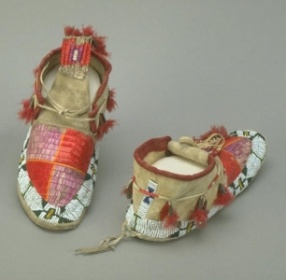|
|
Hanpa ksupi, c.1880
Woman's puberty moccasins.
|
|||
|
|
||||
|
|
This design often represents the four directions meeting in the centre. The young girl is becoming a young woman. |
Puberty was a significant time for Dakota/Lakota women, as girls were now able to become life givers. A highly respected older woman may have made this footwear for a very important daughter. The detailed work includes five styles of quillwork as well as trailers (fringes), which would leave a track if the woman was ever abducted. The brightly coloured quillwork, feathers, and beads would have been visible from a distance. Red plumes may represent a young girl's coming into womanhood. They are usually indicative of a warrior's status, or a warrior's wife. The number of tin cones may be significant: there are seven council fires and seven tribes of the Sioux. Trailers Feathers Quillwork |
| menu |

